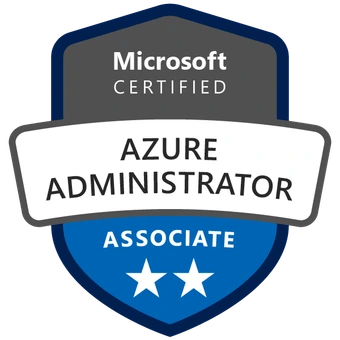ExamPrep AZ-104 Azure Admin.
Offline or Online Azure Administrator AZ-104 ExamPrep training course.
This AZ-104: Microsoft Azure Administrator ExamPrep training and certification is designed for IT professionals who want to implement, manage, and monitor the Azure storage, compute, virtual network and Azure identity service.
This training and certification is a required prerequisite for the Microsoft Certified: Azure Solutions Architect Expert certification.

Manoj S. Mahajan
28+ years Experienced Trainer with 100+ certs, View full profile....Course Description

Our Azure Administrator AZ-104 goes beyond just covering the exam topics; it aims to provide hands-on experience and practical skills necessary for day-to-day Azure administration.
You'll learn to implement, manage, and monitor an organization’s Microsoft Azure environment, including service like virtual networks, storage, compute, identity, security, and governance.
Why join this AZ-104 ExamPrep training?
- Full Official Microsoft syllabus covered by Microsoft Certified Trainer
- Hands-on lab guidance to bridge theory with practical application
- Exam practice questions at the end of each module for reinforcement
- Mock exams to revise and simulate real test conditions

Target Audience:
- An IT Administrators who want to get the practical hands-on knowledge of core Azure services and pass Azure Administrator AZ-104 exam.
- Candidates preparing for the next level Azure certification: Microsoft Certified: Azure Solutions Architect Expert.
Prerequisite:
- IT professionals/developers with some IT experience
- Should know the Windows Server domain, Active Directory (AD). Complete our Windows administration course.
- Knowledge such as OSI model, TCP/IP model, IP addressing details
- Basic knowledge of OS configuration: Disk management, Networking setting, software installation, etc.
- Recommended training Azure Fundamentals completed.
- Attend our FREE introductory Cloud Computing Essentials webinar.
AZ-104 exam details:
- Certification Name: Microsoft Certified: Azure Administrator Associate
- Exam Code: AZ-104
- Exam Duration: 120 minutes
- Number of Questions: 40–60. These can be multiple-choice, drag-and-drop, case studies, and hands-on labs.
- Passing Score: You need a minimum score of 700 out of 1000 to pass.
- Exam Fee: The cost is generally $165 USD, though it can vary by country or region. For example, in India, the price is approximately ₹4,800 INR.
- Validity:The certification is valid for one year and can be renewed by passing a free online assessment.
- Scheduling: The exam can be scheduled and taken at a Pearson VUE test center or through online proctoring.
Syllabus
Please check the syllabus tab above. ☝- Manage Azure identities and governance (20–25%)
- Implement and manage storage (15–20%)
- Deploy and manage Azure compute resources (20–25%)
- Implement and manage virtual networking (15–20%)
- Monitor and maintain Azure resources (10–15%)
What You'll Learn
Manage Azure identities and governance (20–25%)
Manage Microsoft Entra users and groups
- Create users and groups
- Manage user and group properties
- Manage licenses in Microsoft Entra ID
- Manage external users
- Configure self-service password reset (SSPR)
Manage access to Azure resources
- Manage built-in Azure roles
- Assign roles at different scopes
- Interpret access assignments
Manage Azure subscriptions and governance
- Implement and manage Azure Policy
- Configure resource locks
- Apply and manage tags on resources
- Manage resource groups
- Manage subscriptions
- Manage costs by using alerts, budgets, and Azure Advisor recommendations
- Configure management groups
Implement and manage storage (15–20%)
Configure access to storage
- Configure Azure Storage firewalls and virtual networks
- Create and use shared access signature (SAS) tokens
- Configure stored access policies
- Manage access keys
- Configure identity-based access for Azure Files
Configure and manage storage accounts
- Create and configure storage accounts
- Configure Azure Storage redundancy
- Configure object replication
- Configure storage account encryption
- Manage data by using Azure Storage Explorer and AzCopy
Configure Azure Files and Azure Blob Storage
- Create and configure a file share in Azure Storage
- Create and configure a container in Blob Storage
- Configure storage tiers
- Configure soft delete for blobs and containers
- Configure snapshots and soft delete for Azure Files
- Configure blob lifecycle management
- Configure blob versioning
Deploy and manage Azure compute resources (20–25%)
Automate deployment of resources by using Azure Resource Manager (ARM) templates or Bicep files
- Interpret an Azure Resource Manager template or a Bicep file
- Modify an existing Azure Resource Manager template
- Modify an existing Bicep file
- Deploy resources by using an Azure Resource Manager template or a Bicep file
- Export a deployment as an Azure Resource Manager template or convert an Azure Resource Manager template to a Bicep file
Create and configure virtual machines
- Create a virtual machine
- Configure Azure Disk Encryption
- Move a virtual machine to another resource group, subscription, or region
- Manage virtual machine sizes
- Manage virtual machine disks
- Deploy virtual machines to availability zones and availability sets
- Deploy and configure an Azure Virtual Machine Scale Sets
Provision and manage containers in the Azure portal
- Create and manage an Azure container registry
- Provision a container by using Azure Container Instances
- Provision a container by using Azure Container Apps
- Manage sizing and scaling for containers, including Azure Container Instances and Azure Container Apps
Create and configure Azure App Service
- Provision an App Service plan
- Configure scaling for an App Service plan
- Create an App Service
- Configure certificates and Transport Layer Security (TLS) for an App Service
- Map an existing custom DNS name to an App Service
- Configure backup for an App Service
- Configure networking settings for an App Service
- Configure deployment slots for an App Service
Implement and manage virtual networking (15–20%)
Configure and manage virtual networks in Azure
- Create and configure virtual networks and subnets
- Create and configure virtual network peering
- Configure public IP addresses
- Configure user-defined network routes
- Troubleshoot network connectivity
Configure secure access to virtual networks
- Create and configure network security groups (NSGs) and application security groups
- Evaluate effective security rules in NSGs
- Implement Azure Bastion
- Configure service endpoints for Azure platform as a service (PaaS)
- Configure private endpoints for Azure PaaS
Configure name resolution and load balancing
- Configure Azure DNS
- Configure an internal or public load balancer
- Troubleshoot load balancing
Monitor and maintain Azure resources (10–15%)
Monitor resources in Azure
- Interpret metrics in Azure Monitor
- Configure log settings in Azure Monitor
- Query and analyze logs in Azure Monitor
- Set up alert rules, action groups, and alert processing rules in Azure Monitor
- Configure and interpret monitoring of virtual machines, storage accounts, and networks by using Azure Monitor Insights
- Use Azure Network Watcher and Connection Monitor
Implement backup and recovery
- Create a Recovery Services vault
- Create an Azure Backup vault
- Create and configure a backup policy
- Perform backup and restore operations by using Azure Backup
- Configure Azure Site Recovery for Azure resources
- Perform a failover to a secondary region by using Site Recovery
- Configure and interpret reports and alerts for backups

Poonam
Overall a very informative training session. Course content got well covered and also demonstrated the concept very well. Read more....

Ganesh
It was good experience with trainer and teaching skill good and interact and answering every questions asked by student. Good knowledge and updated with his reliable courses. Read more....

Diptikesh
It was an excellent experience to have a training from Certification Guru. Thank you very much. Read more....




